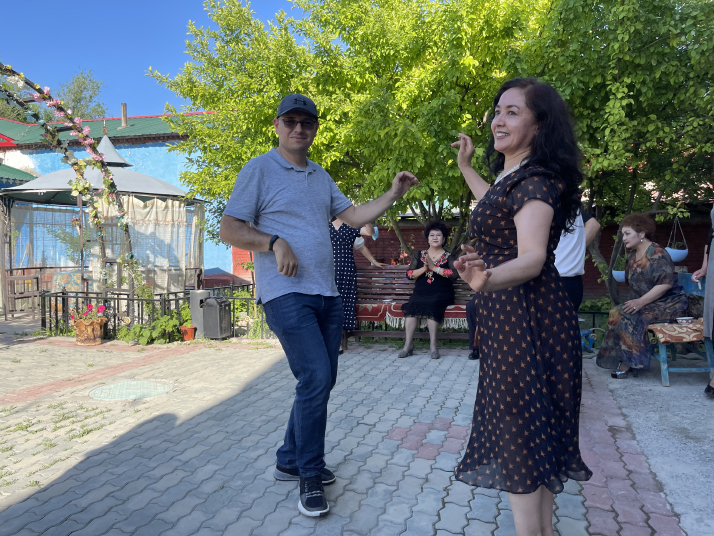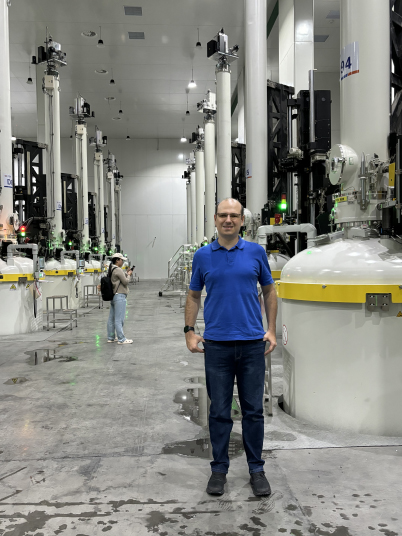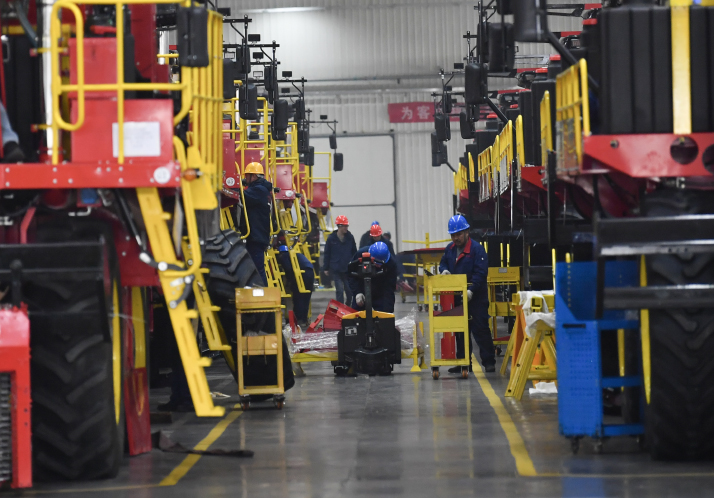| Xinjiang Today |
| Pivotal drivers of Xinjiang's revival | |
|
|
 Rafael Henrique Zerbetto dances with a local resident in Tacheng (COURTESY PHOTO)
During my childhood and youth, I learned at school about the fall of Constantinople and its impact on the decline of the ancient Silk Road. Brazilian schools do not emphasize the ups and downs of the regions along the Silk Road routes—Xinjiang was not even mentioned in those lessons. Instead, they detail the search by European powers for alternative routes that led to the European discovery and colonization of a new continent across the Atlantic. Only after moving to China did I have the opportunity to study the history of the Silk Road from a different perspective and understand that, despite the fact that trade with China was reestablished by sea, allowing the country to further export its silk, porcelain and tea to distant countries by maritime routes, the decline of the overland routes had serious implications inside China.  Zerbetto at a silicon factory in Hami City (COURTESY PHOTO)
A new wave of development Maritime transportation experienced further development after the decline of the Silk Road, with bigger and safer ships carrying more goods for lower cost. After China started its reform and opening up in 1978, the country had to prioritize the industrial development of the eastern coastal regions in order to facilitate access to its major ports. Only after China reached a higher level of development did Xinjiang begin to enter a new period of development. First, the growth in the average income of Chinese people promoted the development of the domestic market. Second, China's technological advancement and rising investment capacity made international trade routes across Xinjiang competitive again. During a visit to a factory producing machinery for the textile industry, I was informed that Urumqi, Xinjiang's regional capital, is too far from ports, making products less competitive if sent by ship. After international cargo lines by train and truck were established, shipping local products to foreign countries became cheaper and faster, giving Xinjiang an advantage in this sector. In recent visits to Xinjiang, I saw cargo trains departing to Central Asia and Europe and also trucks crossing the border with Kazakhstan, carrying products from different places in China. China's investment in multimodal transportation and infrastructure modernization and interconnection has paid off. Just as they did during the times of the ancient Silk Road, goods flow not only from China to the world, but also the opposite way. The trains returning to China from Europe and Central Asia cross Xinjiang carrying a variety of imports, making Xinjiang an essential gateway for China's international trade.  Workers assemble cotton harvesters at a factory in Tacheng Prefecture in February 2024 (XINHUA)
A modern industry Competitive logistics has also driven industrial development in the region. Different kinds of industrial products are made in Xinjiang and exported around the world. From processed food to agricultural machinery, from solar panels to wind turbines, and from traditional handicrafts to hi-tech products, Xinjiang's industrial sector is growing fast and is deeply integrated into domestic and international distribution chains. In Hami in east Xinjiang, I visited a factory producing blades for wind turbines. On another occasion, in Huoerguosi (Khorgas or Horgos) in west Xinjiang, I saw trucks carrying similar blades to Kazakhstan, probably from that same factory I visited in Hami. And here we come to another important topic: Xinjiang's contribution to energy transition on a global scale. Not only wind turbines, but also solar panels are produced in Xinjiang. My exploration of the region showed me that Xinjiang is not merely assembling those products, but also developing production chains, transforming raw materials into components to be later used in the assembly line. The industrial takeoff in Xinjiang will surprise those with a stereotyped idea of the region: When entering a factory in Xinjiang, you will see a clean place with few workers and, in many cases, will find yourself surrounded by automated production lines of intelligent manufacturing plants. The relatively low production cost in the western regions of China, together with governmental incentives for the development of the country's less developed areas and big improvements in infrastructure, alongside the region's proximity to many other countries, make it attractive to companies from home and abroad. A welcoming environment Xinjiang is also very attractive because of its spirit of openness and inclusiveness, forged by the ancient Silk Road, when merchants from far places used to cross its deserts and grasslands. Local people became used to welcoming those voyagers and assisting them in their journeys. Even after the decline of the Silk Road, Xinjiang maintained an intense regional trade with neighboring countries in a spirit of win-win cooperation. During my visits, I have heard many interesting stories of people in Xinjiang welcoming people from other parts of China and abroad who have fallen in love with the region. A local horse breeder, who was born and grew up in the region's vast grasslands, said his maternal grandmother came from Kazakhstan, while his father was an engineer from Zhejiang Province, east China, who came to Xinjiang for work and eventually decided to stay. Another story was told to me by Ma Jirong, Imam of the Shaanxi Grand Mosque in Yining, Ili Kazak Autonomous Prefecture. He is from the Hui ethnic group. Ma told me that Hui soldiers were sent from Shaanxi Province in northwest China to Ili during the reign of Emperor Qianlong (1736-96) in the Qing Dynasty (1644-1911) to suppress a rebellion. After they had finished, the soldiers asked to remain in Xinjiang as they were enjoying the place. The emperor not only allowed them to stay, but also ordered the construction of the mosque for them. This is why the Shaanxi Grand Mosque has the typical architectural style of the Hui ethnic group. In Xinjiang I met families from different ethnic groups, including mixed ones. This open and inclusive environment makes Xinjiang easy for people from other places to adapt to—another advantage of the region as a business destination. Spirit of openness Now, China's deepening opening up is advancing the development of its western regions, especially Xinjiang, which plays a key role in the Silk Road Economic Belt, an essential part of the Belt and Road Initiative (an initiative proposed by China in 2013 to boost connectivity along and beyond the ancient Silk Road routes, consisting of the Silk Road Economic Belt and the 21st-Century Maritime Silk Road—Ed.). The 2025 (China) Eurasia Commodity and Trade Expo, taking place in Urumqi in June, is a platform to further promote international exchange based on the Silk Road spirit of openness and inclusiveness. In contemporary Xinjiang, camels and horses have been replaced by trucks and trains, but the key concept of mutual benefit from exchanges with other countries remains the same. XT The author is a Brazilian journalist with China International Communications Group Comments to ffli@cicgamericas.com |
|
||||||||||||||||||||||||||||
|